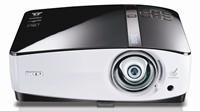
Earlier this year, Epson and Boxlight made news when they introduced projectors that can turn virtually any surface into an interactive whiteboard (IWB). The development meant that schools no longer have to buy separate hardware to enjoy the benefits of IWBs, whose interactive surface and ability to engage students have made them popular in classrooms.
Now, Texas Instruments has developed a similar ability for projectors that use its Digital Light Processing (DLP) technology, while taking this ability one step further: TI’s new technology gives users the ability to interact with a projector’s beam of light from anywhere in the room, on virtually any surface, without the need for cumbersome calibration.
“My mom is a teacher, and I heard her frustration expressed more than once about the limitations of being tied to the front of the room when teaching—she couldn’t help kids out in the back of the class without stopping the lesson and having kids out of their chairs creating a disturbance,” said TI engineer Marshall Capps, who invented the technology. “I thought of a way to remedy these issues and created something that allows presenters to spend more time sharing information in a collaborative way.”
The technology allows users to make notes digitally on the projected image with a handheld pen device. Digital patterns from the pen are detected and then sent to the projector over a radio frequency. All information is passed to the computer in the same way as any other mouse or pointer device, and instructors can use the technology with any software, on any surface without purchasing any additional hardware beyond the pen and projector.
Unlike that of other interactive projectors, TI’s technology doesn’t require calibration steps and doesn’t tie the presenter to the screen or front of the room, the company said. The instructor can move around the room, or hand the pen to someone at the back of the room to interact with the projected content.
“The value of an interactive solution is undeniable,” said John R. Martin, director of learning resources for Tarrant County College’s Northwest Campus. “When people have the opportunity to be a part of the presentation, information seems to be better understood and retained, making a DLP projector more of a collaboration tool than before.”
The technology already has been incorporated into certain models of DLP projectors from manufacturers that include Acer, BenQ, Dell, InFocus, and ViewSonic, TI said.
As for Epson, it debuted the PowerLite S9, a $499 projector for education that features 2,500 lumens of brightness and SVGA resolution. The PowerLite S9 is intended to replace Epson’s PowerLite S7 model, which cost $529 and offered 2,200 lumens of brightness.
Epson also introduced an ultra-mobile series of PowerLite projectors, the 1700 series, that are only 1.7 inches tall and weigh about three pounds. There are four models in the series, ranging from 2,600 lumens and XGA resolution to 3,000 lumens, WXGA resolution, and full networking capabilities. All offer USB plug-and-play connectivity, Mac compatibility, and horizontal and vertical correction (which is automatic on the higher-end models), Epson said.
Energy efficiency
Samsung has introduced what it says is the first LED projector that uses 3LCD technology, the F10M. It’s also the first LED projector to offer 1,000 lumens of brightness, Samsung says. The LED lamp is extremely energy efficient, with a reported lifespan of 30,000 hours—or more than seven times that of a traditional projector lamp. The F10M features XGA resolution and projects an image of between 30 and 400 inches. It also offers instant on/off functionality, requiring almost no warm-up time and producing a nearly instantaneous image, Samsung says. The list price for the F10M is $1,299, which is more than the cost of an entry-level projector—but it could save schools money in the long run by eliminating the need for expensive lamp replacements.
Samsung also touted its new palm-sized pico projector—known as the SP-H03—which features an integrated multimedia player and a high-resolution LED output that is suitable for presentations in smaller classrooms. The six-ounce device easily can be carried in a pocket or briefcase, and educators can present images of up to 80 inches to their students, according to the company. As with the F10M, the SP-H03’s LED lamp is designed to last up to 30,000 hours.
- CIESC Member Schools Gain Access to Metrasens Ultra Weapons Detection Systems Through New Partnership - April 24, 2024
- SchoolStatus Launches SchoolStatus Boost, an Innovative Educator Development Solution for Enhanced Teacher Growth and Development - April 22, 2024
- Frontline Education Releases Inaugural K-12 Lens Survey Report To Guide K-12 Decision-Making - April 20, 2024

